Note: many of the links I included are not highlighted (thank you, WordPress). Also, many of the links are to sites that no longer exist. Sorry about that, but I have no control over stuff that’s not mine.
Some years ago my mother gave me one of her father’s binoculars. They look old, beat up, do not have a diopter adjustment, and the angle between the lenses is fixed. But they work, and they work well.
Even the compass still works, and turning the wheel will raise and lower the tubes to focus to the desired distance.
By the way, I would strongly suggest reading the post and then visiting the SmugMug gallery . . . the full size pictures are much nicer.
My grandfather’s name was Giovanni Nicolich. He married Maria Badurina, and they had four children. The picture below shows them on their wedding day, October 1924.
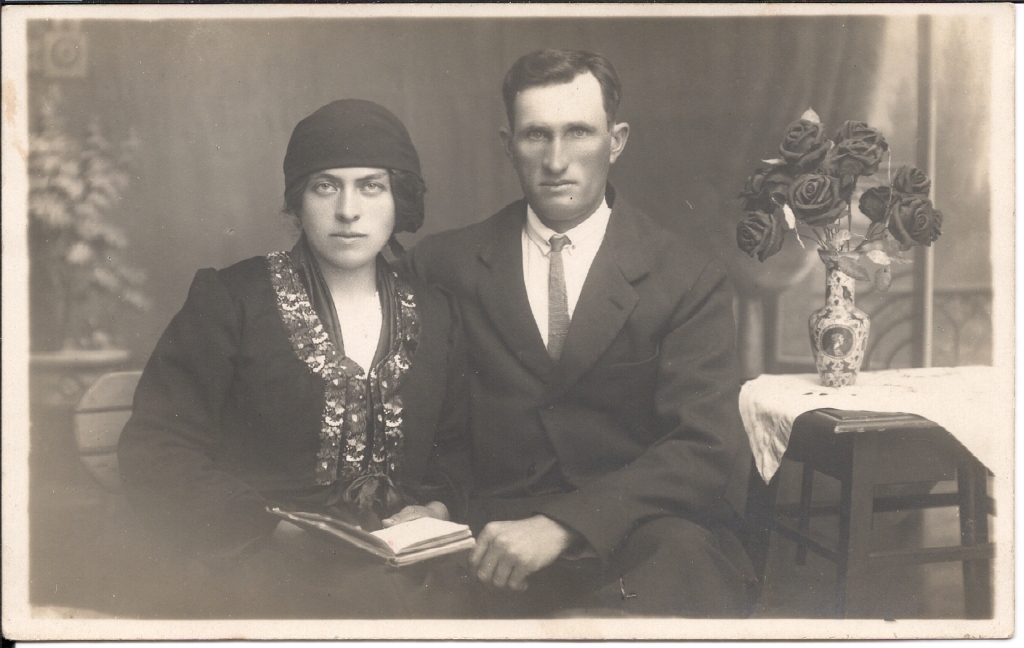
My grandmother is wearing the black scarf and costume from the town of Neresine. They lived in Lussinpiccolo, and both towns are part of the Cherso-Lussino archipelago. These days those places go by the names of Nerezine, Mali Losinj, Cres-Losinj, and the area is today part of Croatia.
The Wikipedia entry for Cres-Losinj gives the history of the place, but for those not wanting to click on the link here is a brief summary:
1797 – fall of Venice; island becomes part of the Austrian province of Istria.
1919 – island becomes part of Italy (the population was already primarily Italian)
1943 – German and Croatian troops occupy it as part of Operation Zone Adriatic Coast
1945 – island and rest of Croatia become part of Yugoslavia
(Note: over the next few years much of the Italian population emigrated, legally or by escaping, and are spread throughout the world. They keep in touch and obtain updates through this publication. It is in Italian, and documents the accomplishments of Lussignani, and their passing. This particular one I linked contains the notice for the passing of Marino Nicolich.)
1953 – yours truly is born in a part of Yugoslavia that is now Slovenia
1955 – the family leaves Lussinpiccolo (Mali Losinj) and settles in Friuli-Venezia Giulia
1991 – Croatia declares independence from Youguslav rule (the same year as Slovenia)
Boring to all who are not from there, it becomes interesting when someone asks me about my nationality. Ostensibly, prior to becoming a U.S. citizen, I was Italian . . . emigrated from what now is Croatia, but was born in Yugoslavia, in what is now Slovenia, from parents who were born Italian, and whose parents were born under Austrian rule. Usually, I just say “Italian”.
It is a beautiful area, and a popular tourist destination dating back to Roman times. For those who want to take a look at the area and look up the names of the towns I mentioned, this map of the archipelago has the current Croatian names, and each is a link to a short description and history of the town.
Better yet, this site has an interactive exploration applet that is one of the best I have ever seen, letting you fly to any of the ports, towns, and landmarks. I am surprised by the quality of this site, but then the area is world-known for sport fishing, and tourism appears to be a vibrant part of the local economy.
But back to the story . . . by 1939 Giovanni and Maria had four children.
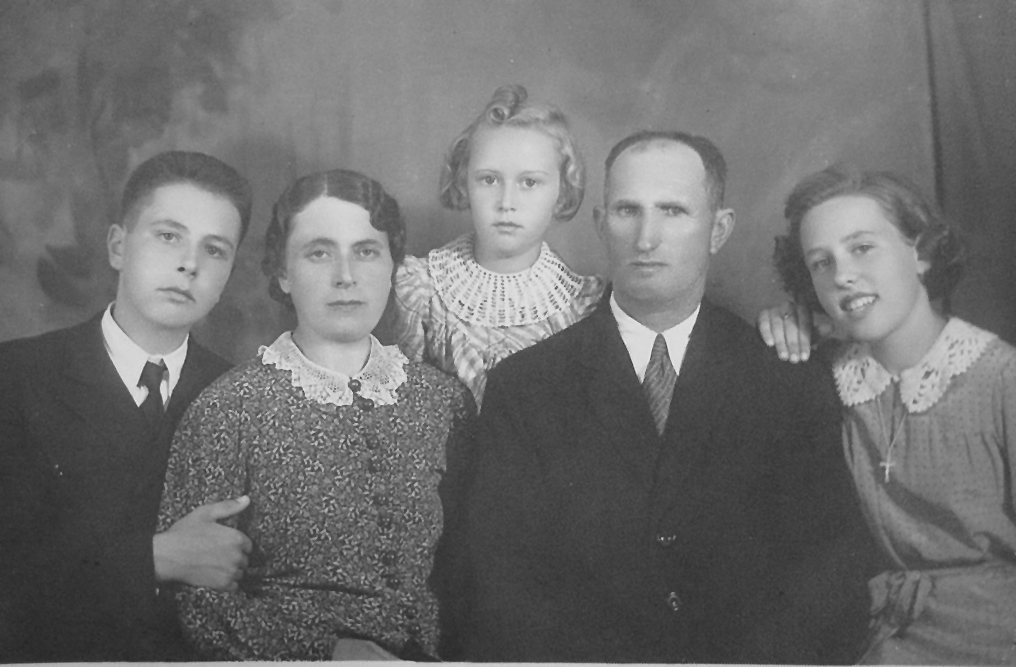
The names make it a bit confusing, even more so because there are also nicknames and dialect names associated with each (not germane to this post). The daughter on the right died of meningitis in 1941, and they had another son, Marino, in 1944. My mother is the only survivor; my uncle Giovanni died last year, and my uncle Marino in 2007. My grandfather died in 1970, at the age of 77, and my grandmother died in 1987, at the age of 85.
My grandfather was a sailor. He operated a small merchant boat, the Santa Maria, traveling between the ports, moving both merchandise and people.


I mention all this because it’s tied to the story of the binoculars. Might as well add a picture here to remind people of them.
 From where the family lived in Lussinpiccolo (Mali Losinj), they could see when the Santa Maria would leave Punta Croce (Punta Kriza), and these binoculars were the favorite to do so because of their quality and magnification.
From where the family lived in Lussinpiccolo (Mali Losinj), they could see when the Santa Maria would leave Punta Croce (Punta Kriza), and these binoculars were the favorite to do so because of their quality and magnification.
They had a few different binoculars and a telescope, but my mother speaks of using these to track the comings and goings of her father’s boat.
It is difficult to know just how old these are. They were in the family before my mother was born, so they are at least 80 years old.
I would venture a guess they are older. On each of the sliding tube there are inscriptions. One is in French,
and the other is in German,
Both loosely translate to something like “Improved Military Binoculars”. The fact they are in those languages points to sometime before 1919 when the area was under the Austrian empire.
Except for the compass between the eyepieces, these French Galilean binoculars 6 x 45 “Colmont” Paris 1910 look a lot like them. The power seems about right. Of course, the ones shown on that site are in much better shape.
These also have dust inside the lens, and strange flaws which resemble stars.
Subsequent to me taking the pictures, I took these apart. As the name Galilean implies, they are not prism binoculars, so I did not have to worry about realigning them when putting them back together again.
They use refracting optics. They use an objective lens and an eyepiece, and the focus is controlled by sliding the two relative to each other. Essentially they are two telescopes attached at eye-width. I cleaned the lenses of the accumulated dust. The dust probably comes in through the clearance around the telescoping tubes.
The star-like flaws are actually inside the lens itself and appear to be a crystallization of some type, although a quick search of the Internet does not reveal any similar examples. Perhaps someone reading this can shed some light on what those are and why they form.
So, here we are, nearly at the end. It’s funny; this post was primarily to showcase these next two pictures and got derailed by my wanting to know more. The old pictures shown above I got by contacting my sister, the details about the binoculars from my mother, along with the stuff about the place where they lived. My curiosity about the relationship between where they lived and the waters my grandfather sailed led me to find the history and maps I link above.
And now we are back to what I wanted to show in the first place. Honest, not for the first one, but for the second of these next two pictures, I suggest clicking on the picture to see the high-resolution version in the SmugMug album. The first picture is a regular single photograph showing the binoculars, a decent picture with a shallow depth of field.
But the second photograph blew me away when I first saw it. It’s a composite of six photos merged using the Blended Layers technique I mentioned before. The details are stunning and look almost three-dimensional to me. Go to SmugMug and click on it to see it in its original size (choose the “O” option or at least the “X3” option).
First, the single-shot photo. As an aside, this view immediately reminded me of Wall-E.
And here is the Blended Layers photo (six layers).
Thanks for reading this post. I hope you enjoyed reading it as much as I enjoyed writing it.
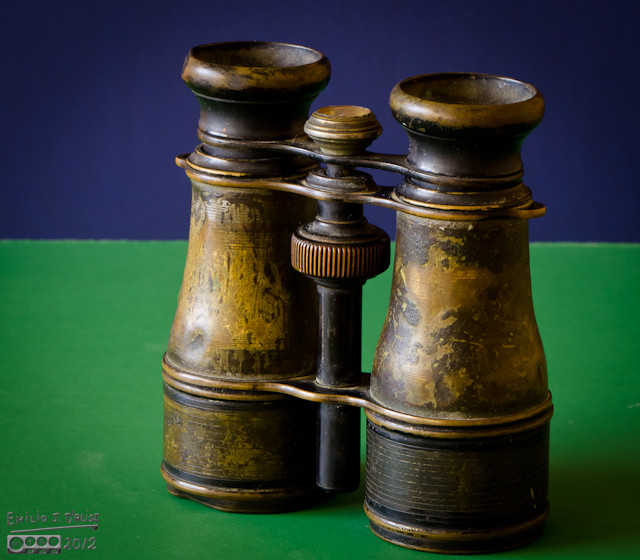

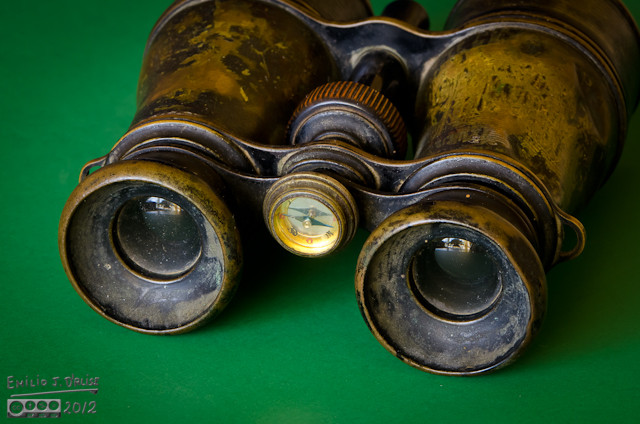
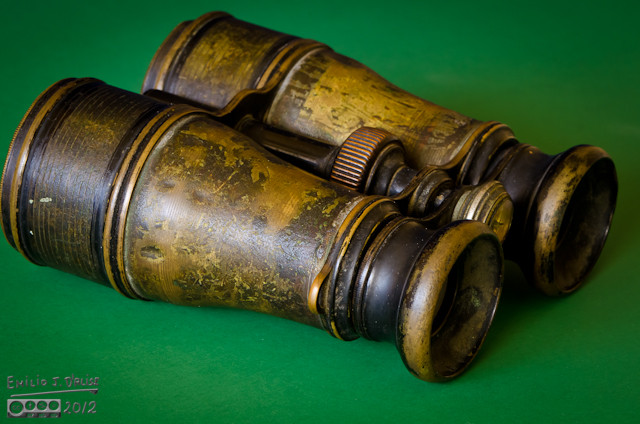
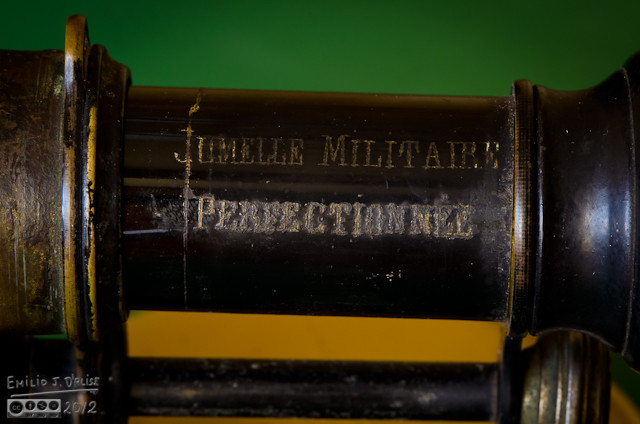

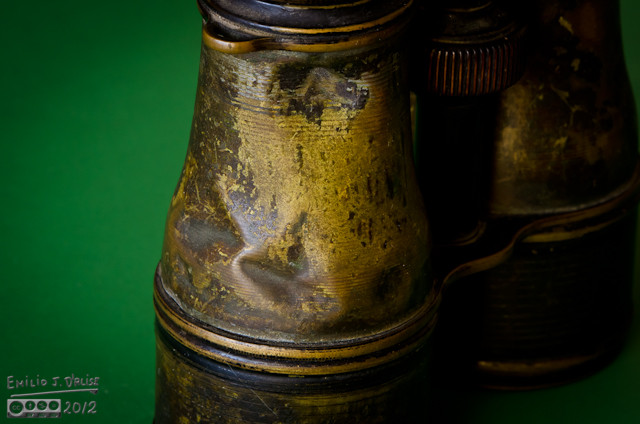
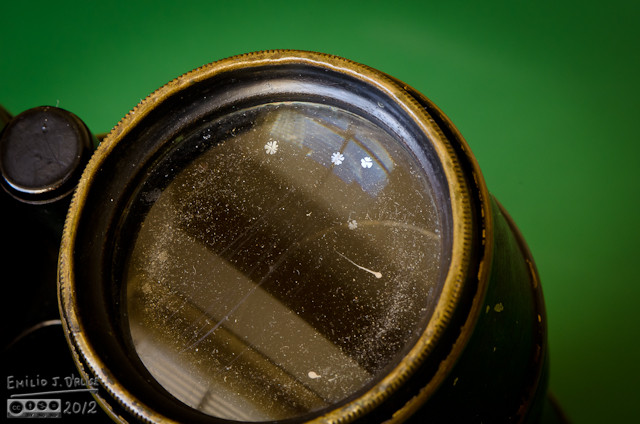
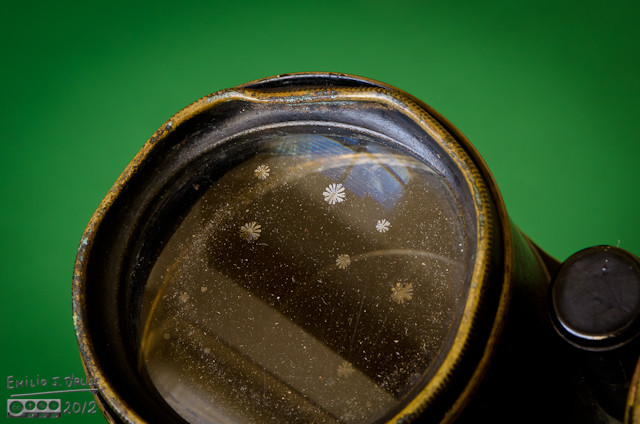

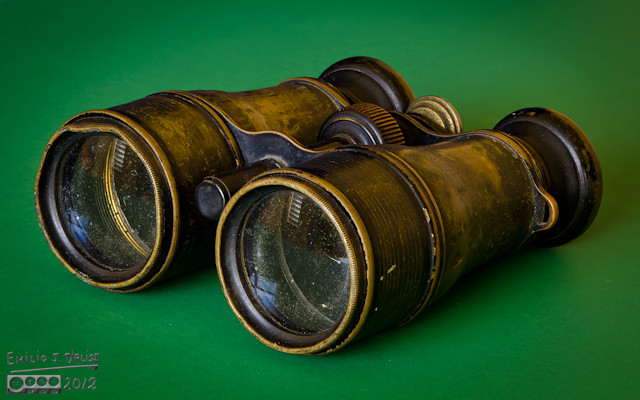
Those binoculars look like they have lived a long and interesting life, as has your family. Thank you (and your sister and mother) for the pictures and stories about your grandparents and your family, which made seeing the binoculars so much more special. Really enjoyed this post.
LikeLike
Thanks Sandy. Like I said, this started as a 3-4 picture post as part of the PATH series, and quickly took on a life of its own. The difficulty was trying to find a balance between too much information and not enough.
Glad you enjoyed it.
LikeLike
Ciao Cugino, I loved reading your post! The binoculars are simply amazing. What a wonderful keepsake your Mother shared with you. Thanks for sharing a little bit of your family history and the history of Lussin with the blog world. It was a great read. I’m often at somewhat of a loss for explaining my heritage but now I can point people to your post as it illustrates our people’s history so well in the timeline that you posted. I hope you are doing well. AnnMarie sent a link to your blog and I’m so glad I stopped by for a visit. You’re an amazing writer and photographer. I’ll be back for a visit. Ciao, Ciao, Debbie
LikeLike
Holy cow! Debbie!!
When I wrote this I wondered if I was going to hear from people, some I might not even remember, from the area.
I am definitively happy to hear from you, and am glad you liked the post.
LikeLike
Yup, your star just got a little brighter . . . looking forward to other joint ventures . . . just an idea, I know.
Anyway, I TOLD you you’re a great photographer and writer. Now others are finding out, too. So there!
LikeLike
Bella esposizione , appassionata e concisa, della storia della vostra famiglia che in parte è anche la mia. Le stelle che si vedono imprigionate tra le lenti voglio pensare siano le stesse che hanno guidato e protetto Nonno Jve nella navigazione notturna. Grazie per avermi reso partecipe. Mariella
LikeLike
Grazie altrettanto per il messaggio, e per esprimere proprio il mio pensiero per quanto riguardano le stelle..
LikeLike
Tutto quello che è vecchio e che appartiene alla famiglia mi piace da morire, perchè è parte della propria storia e cultura… e anche questa storia è bellissima e benissimo raccontata. E poi riguarda anche una delle più care persone che ho, Nives, e della sua famiglia… Grazie. George, da Percoto UD
P.s. le stelle su una lente ricordano tanto la Croce del Sud Australiana…. o almeno pare a me….
LikeLike
Grazie per aver visitato. E sono d’accordo, le stelle assomigliano la Croce del Sud.
Spero che avete letto l’articolo in Inglese perché la traduzione lascia molto a desiderare. Io ho usato “Google Translate”, e ovviamente a Google non grada il mio stile di scrittura.
LikeLike
no worry, i read in original language…. at least, for us Google Translate is something of funny and nothin else…
LikeLike
Wow! I’m so very happy that you posted such a well written article and, as always, such awesome photos! This might sound silly, but taken from a great movie, “You build it and they will come” and they did. Beautifully written and very proud too!
LikeLike
Both my Mom and I loved and enjoyed the article and the photos. You have a great gift. We like to see another.
LikeLike
emilio, this is very interesting about your ancestors. do you have more to tell?
LikeLike
Not really. I tend to live in the present, with a toe or two feeling my way into the future.
Nonna and nonno were part of my life, and I still remember them, hence my interest in getting the particulars right. The other side of my genetic makeup are just names, and I have no interest in finding out more.
LikeLike
Some sparks of Zen-ism. Not sure, how to clean the stars, but the crap i found here is pretty much WoW!! 🙂 Thanks!
Btw, I am Kam from India, started following your blog for my own addiction for stuff very rare and interesting (at least to me) like this. Will keep dropping by,
Kam
LikeLike
Thanks Kam, but I should mention this is a one-off post. I mostly photograph scenery, animals, flowers, birds.
I am doing a series about stuff I have in the house, but this was unique as far as being old and having a history associated with it.
LikeLike
I enjoyed your article on the binoculars…and about the family history……and also liked the pictures of the family and the boats…the Santa Maria …a subject about which I like to read..
Always great to rear of connections of fellow Lussignani…
Maj
LikeLike
I might be misunderstanding . . . did you know of the Santa Maria? Were you or your family there during the time I mention?
I’m asking because my mother does not recognize your name, and was wondering of your connection to the island since you imply you live or lived there.
LikeLike
Adjusting what area to secure your sheath is a matter of
personal preference, whether it be at the ankle, leg or any other area.
As a hunter and outdoorsman this is something that has
been a debate for many years among my friends and family who are also
outdoorsmen. It can be imperative to your knife needs to be well suited for your.
LikeLike
Well, I contend the axe is not important when eating apples. Furthermore, wanting to flower the tree would be better if butter is in liquid state.
Just imagine bee not the bonnet green smell.
And, of course, as always, rock crushes scissors.
LikeLike
I enjoyed reading this post Emilio. I love family history and your story is fascinating. I too am Italian but was born in Australia. My parents immigrated here in the 50’s and my father worked hard in the hot Australian sun building this country to what it is today….well you know how the rest of it goes. I went to my parents home town, Torino di Sangro, when I was in Italy and it was very special and emotional for me. I’ve heard for so many years stories about their lives, my grandparents lives and I was finally able to see it all. Anyway I won’t bore you with my story. Thanks for sharing yours with me 🙂
LikeLike
Thank you, Norma, and stories are seldom boring; perhaps you might enjoy doing a post about your discoveries as much as I enjoyed doing this one.
LikeLike
Great photographs but the binoculars knocked me back a bit as except for the compass they were so like my father’s binoculars but I don’t know what happened to them.
LikeLike
Those binoculars were popular, at least from what I understand. The optics are surprisingly good given the age and usage.
LikeLike
I wondor egad could they perhaps be Swiss made binoculars, if memory serves me both French and German ( and Italian?) are official languages of Switzerland, which might account for the writing in both those languages?
LikeLike
They might be, but I found other information of the same binoculars (without the inscription) and they were listed as French. Although, there are hints that models were copied, and a similar models were labeled with different origins, not so much where they were made, but who sold them.
Here’s some images available online: http://bit.ly/1Mm5ah4
These, in particular, look very close to the ones I have:
http://tedbrink.webs.com/france9.htm
LikeLike
I love your post I’m born in Losinj have a lot of friend’s in Nerezine, and always like to see old picture and stuff from my home island, thank you. ….
LikeLike
Glad you enjoyed it.
I’ve never visited there, but my mother has gone back a number of times as well as my now-deceased uncle. Perhaps someday, but currently unlikely.
LikeLike
I greatly enjoyed reading this, Emilio! It’s wonderful to hear about your family history! And the binoculars are a precious keepsake!
HUGS!!! 🙂
LikeLike
Thanks, diem3 . . . pretty much, this is the sum total of what I know about my ancestors. I suppose this will one day seem strange to kids who will be able to see videos and read facebook posts of their ancestors from about the 90s onward.
LikeLiked by 1 person
Well you certainly held my attention throughout with this post Emilio, pity you’re not like this more often, you actually appear human.
Must admit that grandpa doesn’t look the happiest of men on his wedding day, or with his 3 children, what a shame that sweet young girl with the lovely smile dying so young and from such a nasty disease, your uncle looks about as happy as his daddy.
I can see where you get your vivacity from.
LikeLike
I think the “look” is more an indication of what was expected of photos in those days combined with needing to be still. Of course, it could also be a reflection of the times. That had to have been close to the onset of WW II if not already in it.
But, if you’re backward judging them based on me, you pretty much got it wrong because I’m very much the goofball. Annoyingly so, from when I get up to when I reluctantly give concession to the brain’s need for sleep.
I mean, it doesn’t come across here because my brand of humor often gets confused with me just being a jerk. Regardless, trust me, I’m far from dour and as far as vivacity, why, it’s what keeps me from gaining weight, especially given the amounts of food I eat.
Glad it held your interest.
LikeLike
The photo of the wedding was taken in 1924 15 years before the start of WWII; but being still relatively close to the end of WWI that might have had effect, after all it was an incident at Sarajevo that sparked the Great War, and perhaps the people of Croatia were getting some of the blame being near neighbours
Yes it was a very good post 🙂
LikeLike
I was referring to the photo with the kids.
That whole area went through a number of hardships as various factions argued over it. I mean serious hardships . . . no Twitter, no Facebook, no PCs or smartphones. Frankly, I don’t know how people lived back then. I heard they had books, but they had no readers for them, so I don’t understand what good they were. The Kindle would not be invented for another 80 years or so.
LikeLike
Thank you for this sharing of your grandparents information. I’m helping my mom research her tree and her Badurina family is from the island of Pag, so do you know if Maria is from there please?
LikeLike
I’ll forward the request to my sister and mother and ask them to respond here.
LikeLike
Here’s what my mother, Nives, recalls about her mother Maria Badurina’s family (this spoken by her):
My grandfather was Nonno Beppo (Giuseppe) Badurina born on the island of Cherso (now Cres) in Neresine. His father, Bisnonno Badurina (my great-grandfather) was born on the island of Pago, but moved to the island of Lussino (now Losinj) as a young man. He lived and worked in Lussin Grande in a villa as a servant. When the owner of the house passed away, she left it in her will that the islands of Palaziol and Oruda were to be inherited by Beppo. So after she passed, Bisnonno left Lussin Grande and moved to either Punta Croce or Neresine. I do not recall whom he married or when, but his Badurina children (my Nonno Beppo, Barba Ive, and three sisters, Francesca, Maria and Zuva) were probably all born in Neresine. Bisnonno’s son Beppo married Maria Pinesich of Neresine and had 9 children, the first being my mother, Maria, born in 1902. Maria Badurina then married Giovanni Nicolich (from Lussinpiccolo) in 1924 in Punta Croce, but returned to Lussinpiccolo where my father lived and worked. They left the island in 1955, this due to Croatia becoming Communist Yugoslavia.
Sorry that my mother does not recall any details of her Bisnonno’s time on the island of Pago, or his family connections there.
LikeLike
I received a reply from our cousin Mariella (daughter of Maria Badurina’s sister). Unfortunately, her mother does not recall her grandparents’ names. Mariella did write me that the reason Bisnonno Badurina inherited the two islands was because he married the 70-ish-year-old wealthy widow. Mother had heard this many years ago, but it had been denied by several of Nonno Beppo’s other living children. Also, when half of one of the above mentioned islands was put up for sale about 30 years ago (another long story), our mother contacted her cousin in Lussinpiccolo to get the details and was duly informed that direct descendants of the Lussin Grande widow had come forth in numbers to claim pieces of that island and that it would be an uphill battle to get all the legalities resolved. This rather confirms that a marriage may have never taken place and that the widow’s direct descendants may still have legal rights to these islands. As far as mother is concerned, she has not heard that this property was sold. She’s sure someone would have told her.
Anyway, because land records were not always drawn (and many were only verbal agreements) or kept up-to-date, a one-acre lot may belong to a dozen people going back generations. This, needless to say, causes havoc when someone wants to purchase or sell land. Before you can find all the parties involved (most immigrated to all corners of the Earth), confirm their citizenships, send them the documents, get them translated, and finally get them through the legal system . . . well, you’ve got years before anything is resolved . . . if ever.
Disclaimer: The above process has been our family’s personal experiences and does not reflect anyone else’s dealings with property in that country.
LikeLike
Bisnonno means great-grandfather. Does she remember his actual name? She might not, as I for a long time didn’t know nonno’s or nonna’s first names.
Thanks for the translation of the oral history. It’s interesting reading.
LikeLike
Nope, mom doesn’t recall any names before Nonno Beppo. But, if she’s able to get a hold of Zia Ivica (Beppo’s daughter, who just turned 100 and still very clear-minded), she may recall her grandfather’s name. I’ll send an email to Mariella and see what I get back.
LikeLike
Just to clarify and recap for SMoore:
The Badurina ancestor that left Pag settled in Lussingrande (currently Veli Losinj) and inherited property (two islands and maybe more) from the woman he worked for. He then settled in Nerezine, married, and had five children. The eldest, Beppo, had nine children, the eldest being my grandmother Maria. The second son, Ive/Giovanni, also married and had children. Both these men have current male Badurina descendants living in Croatia (islands of Losinj and Cres, in Punta Kriza), in Italy (not name carrying males), in the New York area (direct Badurina males) and around the Chicago area (no Badurina males).
Something that may be of interest is that after World War II, while Lussin was still heavily occupied by the Yugoslavian army, my mother (at that time around 13 years old) and a few friends, met two soldiers on the road near her home in Lussin. These two soldiers introduced themselves, one of them was a Badurina. My mother asked from where, and he replied “From Pag.” She then told him that her mother was a Badurina and invited him to meet her. As it turns out, this soldier was a direct descendant of a brother (in Pag) of the first Badurina that came to Lussingrande. This soldier was able to give Maria more information about her unknown relations in Pag, and that the Badurina name was very common.
LikeLike
Meantime, as I mentioned above, Maria was from the town of Neresine, however, there is a connection to the island of Pag (Pago) as both islands ( and others) are mentioned in these two documents. These are mostly history and events, but they mention some names, including Nicolich. I didn’t see Badurina mentioned, but this makes for interesting reading.
They are in Italian and unfortunately, probably won’t translate all that well.
Click to access Storia%20Neresine.pdf
http://www.istrianet.org/istria/towns/losinj_island/bracco_neresine-storia.htm
These might not help in your family tree search, but might add to the history of the area.
LikeLike